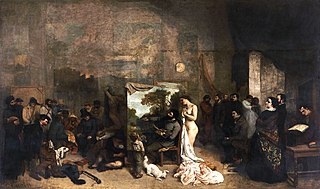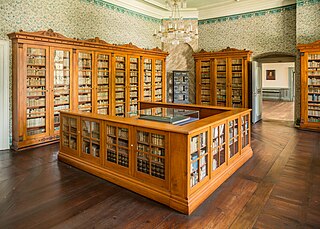Related Research Articles

Alice O'Connor, better known by her pen name Ayn Rand, was a Russian-born American author and philosopher. She is known for her fiction and for developing a philosophical system she named Objectivism. Born and educated in Russia, she moved to the United States in 1926. After two early novels that were initially unsuccessful and two Broadway plays, Rand achieved fame with her 1943 novel The Fountainhead. In 1957, she published her best-selling work, the novel Atlas Shrugged. Afterward, until her death in 1982, she turned to non-fiction to promote her philosophy, publishing her own periodicals and releasing several collections of essays.
Objectivism is a philosophical system named and developed by Russian-American writer and philosopher Ayn Rand. She described it as "the concept of man as a heroic being, with his own happiness as the moral purpose of his life, with productive achievement as his noblest activity, and reason as his only absolute".

Romantic music is a stylistic movement in Western Classical music associated with the period of the 19th century commonly referred to as the Romantic era. It is closely related to the broader concept of Romanticism—the intellectual, artistic, and literary movement that became prominent in Western culture from about 1798 until 1837.

Romanticism was an artistic and intellectual movement that originated in Europe towards the end of the 18th century. The purpose of the movement was to advocate for the importance of subjectivity, imagination, and appreciation of nature in society and culture during the Age of Enlightenment and the Industrial Revolution.
Naturalism is a literary movement beginning in the late nineteenth century, similar to literary realism in its rejection of Romanticism, but distinct in its embrace of determinism, detachment, scientific objectivism, and social commentary. Literary naturalism emphasizes observation and the scientific method in the fictional portrayal of reality. Naturalism includes detachment, in which the author maintains an impersonal tone and disinterested point of view; determinism, which is defined as the opposite of free will, in which a character's fate has been decided, even predetermined, by impersonal forces of nature beyond human control; and a sense that the universe itself is indifferent to human life. The novel would be an experiment where the author could discover and analyze the forces, or scientific laws, that influenced behavior, and these included emotion, heredity, and environment. The movement largely traces to the theories of French author Émile Zola.

The term neo-romanticism is used to cover a variety of movements in philosophy, literature, music, painting, and architecture, as well as social movements, that exist after and incorporate elements from the era of Romanticism.
Pseudophilosophy is a term applied to a philosophical idea or system which does not meet an expected set of philosophical standards. There is no universally accepted set of standards, but there are similarities and some common ground.

Jacques Martin Barzun was a French-born American historian known for his studies of the history of ideas and cultural history. He wrote about a wide range of subjects, including baseball, mystery novels, and classical music, and was also known as a philosopher of education. In the book Teacher in America (1945), Barzun influenced the training of schoolteachers in the United States.

Charles Welles Rosen was an American pianist and writer on music. He is remembered for his career as a concert pianist, for his recordings, and for his many writings, notable among them the book The Classical Style.
In Western classical music, neoromanticism is a return to the emotional expression associated with nineteenth-century Romanticism. Throughout the 20th and into the 21st century, numerous composers have created works which rejected or ignored emerging styles such as Modernism and Postmodernism.

Carl Dahlhaus was a German musicologist who was among the leading postwar musicologists of the mid to late 20th-century. A prolific scholar, he had broad interests though his research focused on 19th- and 20th-century classical music, both areas in which he made significant advancements. However, he remains best known in the English-speaking world for his writings on Wagner. Dahlhaus wrote on many other composers, including Josquin, Gesualdo, Bach and Schoenberg.

The Romantic Manifesto: A Philosophy of Literature is a collection of essays regarding the nature of art by the philosopher Ayn Rand. It was first published in 1969, with a second, revised edition published in 1975. Most of the essays are reprinted from Rand's magazine The Objectivist.

19th-century French literature concerns the developments in French literature during a dynamic period in French history that saw the rise of Democracy and the fitful end of Monarchy and Empire. The period covered spans the following political regimes: Napoleon Bonaparte's Consulate (1799–1804) and Empire (1804–1814), the Restoration under Louis XVIII and Charles X (1814–1830), the July Monarchy under Louis Philippe d'Orléans (1830–1848), the Second Republic (1848–1852), the Second Empire under Napoleon III (1852–1871), and the first decades of the Third Republic (1871–1940).
Post-romanticism or Postromanticism refers to a range of cultural endeavors and attitudes emerging in the late nineteenth and early twentieth centuries, after the period of Romanticism.

The Painter's Studio is an 1855 oil-on-canvas painting by Gustave Courbet. It is located in the Musée d'Orsay in Paris, France.
Literary realism is a literary genre, part of the broader realism in arts, that attempts to represent subject-matter truthfully, avoiding speculative fiction and supernatural elements. It originated with the realist art movement that began with mid-nineteenth-century French literature (Stendhal) and Russian literature. Literary realism attempts to represent familiar things as they are. Realist authors chose to depict every day and banal activities and experiences.

Realism in the arts is generally the attempt to represent subject matter truthfully, without artificiality and avoiding speculative and supernatural elements. The term is often used interchangeably with naturalism, although these terms are not synonymous. Naturalism, as an idea relating to visual representation in Western art, seeks to depict objects with the least possible amount of distortion and is tied to the development of linear perspective and illusionism in Renaissance Europe. Realism, while predicated upon naturalistic representation and a departure from the idealization of earlier academic art, often refers to a specific art historical movement that originated in France in the aftermath of the French Revolution of 1848. With artists like Gustave Courbet capitalizing on the mundane, ugly or sordid, realism was motivated by the renewed interest in the common man and the rise of leftist politics. The realist painters rejected Romanticism, which had come to dominate French literature and art, with roots in the late 18th century.

Romanticism in Scotland was an artistic, literary and intellectual movement that developed between the late eighteenth and the early nineteenth centuries. It was part of the wider European Romantic movement, which was partly a reaction against the Age of Enlightenment, emphasising individual, national and emotional responses, moving beyond Renaissance and Classicist models, particularly into nostalgia for the Middle Ages. The concept of a separate national Scottish Romanticism was first articulated by the critics Ian Duncan and Murray Pittock in the Scottish Romanticism in World Literatures Conference held at UC Berkeley in 2006 and in the latter's Scottish and Irish Romanticism (2008), which argued for a national Romanticism based on the concepts of a distinct national public sphere and differentiated inflection of literary genres; the use of Scots language; the creation of a heroic national history through an Ossianic or Scottian 'taxonomy of glory' and the performance of a distinct national self in diaspora.

Realism was an artistic movement that emerged in France in the 1840s, around the 1848 Revolution. Realists rejected Romanticism, which had dominated French literature and art since the early 19th century. Realism revolted against the exotic subject matter and the exaggerated emotionalism and drama of the Romantic movement. Instead, it sought to portray real and typical contemporary people and situations with truth and accuracy, and not avoiding unpleasant or sordid aspects of life. The movement aimed to focus on unidealized subjects and events that were previously rejected in art work. Realist works depicted people of all classes in situations that arise in ordinary life, and often reflected the changes brought by the Industrial and Commercial Revolutions. Realism was primarily concerned with how things appeared to the eye, rather than containing ideal representations of the world. The popularity of such "realistic" works grew with the introduction of photography—a new visual source that created a desire for people to produce representations which look objectively real.

The more precise characterization and specific definition of Romanticism has been the subject of debate in the fields of intellectual history and literary history throughout the 20th century, without any great measure of consensus emerging. That it was part of the Counter-Enlightenment, a reaction against the Age of Enlightenment, is generally accepted in current scholarship. Its relationship to the French Revolution, which began in 1789 in the very early stages of the period, is clearly important, but highly variable depending on geography and individual reactions. Most Romantics can be said to be broadly progressive in their views, but a considerable number always had, or developed, a wide range of conservative views, and nationalism was in many countries strongly associated with Romanticism, as discussed in detail below.
References
- Abercrombie, Lascelles (1963) [1926]. Romanticism . New York: Barnes and Noble. OCLC 325656.
- Barzun, Jacques (1975) [1943]. Classic, Romantic, and Modern (revised second ed.). University of Chicago Press. ISBN 0-226-03852-1.
- Becker, George J. (1980). Realism in Modern Literature. New York: Frederick Ungar. ISBN 0-8044-2031-9.
- Cowardin Jr., Samuel Pendleton; More, Paul Elmer (1939). The Study of English Literature. New York: Henry Holt and Company. OCLC 2861425.
- Dahlhaus, Carl (1985). Realism in Nineteenth-century Music. trans. by Mary Whittall. New York: Cambridge University Press. ISBN 0-521-26115-5.
- Fanger, Donald (1998) [1965]. Dostoevsky and Romantic Realism: A Study of Dostoevsky in Relation to Balzac, Dickens, and Gogol. Evanston, Illinois: Northwestern University Press. ISBN 0-8101-1593-X.
- Goodrich, Lloyd; Baur, John I. H. (1961). American Art of Our Century . New York: Frederick A. Praegar. OCLC 422186219.
- Rand, Ayn (1995). Berliner, Michael S (ed.). Letters of Ayn Rand . New York: Dutton. ISBN 0-525-93946-6. OCLC 31412028.
- Rand, Ayn (1971). The Romantic Manifesto: A Philosophy Of Literature (revised ed.). New York: Signet. ISBN 0-451-14916-5.
- Sheeran, P.F. (1976). The Novels of Liam O'Flaherty: A Study in Romantic Realism. Dublin: Wolfhound Press. ISBN 0-9503454-6-6.
- Stauffer, Ruth M. (2006) [1922]. Joseph Conrad: His Romantic-Realism. Kessinger Publishing. ISBN 1-4286-5840-8.